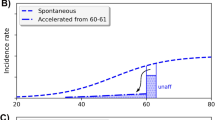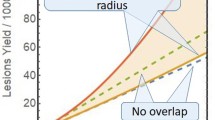Abstract
Improved risk characterization for stochastic biological effects of low doses of low-LET radiation is important for protecting nuclear workers and the public from harm from radiation exposure. Here we present a Bayesian approach to characterize risks of stochastic effects from low doses of low-LET radiation. The stochastic effect considered is neoplastic transformation of cells because it relates closely to cancer induction. We have used a published model of neoplastic transformation called NEOTRANS1. It is based on two different classes of cellular sensitivity for asynchronous, exponentially growing populations (in vitro). One sensitivity class is the hypersensitive cell; the other is the resistant cell. NEOTRANS1 includes the effects of genomic damage accumulation, DNA repair during cell cycle arrest, and DNA misrepair (non-lethal repair errors). The model-associated differential equations are solved for conditions of in vitro irradiation at a fixed rate. Previously published solutions apply only to high dose rates and were incorrectly assumed to apply to only high-LET radiation. Solutions provided here apply to any fixed dose rate and to both high-and low-LET radiations. Markov chain Monte Carlo methods are used to carry out the Bayesian inference of the low-dose risk for neoplastic transformation of aneuploid C3H 10T1/2 cells for X-ray doses from 0 to 1000 mGy. We have assumed that for this low-dose range only the hypersensitive fraction of the cells are affected. Our results indicate that the initial slope of the risk vs dose relationship for neoplastic transformation is as follows: (1) directly proportional to the fraction, f 1, of hypersensitive cells; (2) directly proportional to the radiosensitivity of the genomic target; and (3) inversely proportional to the rate at which hypersensitive cells with radiation-induced damage are committed to undergo correct repair of genomic damage. Further, our results indicate that very fast molecular events are associated with the commitment of cells to the correct repair pathway. Results also indicate a relatively large probability for misrepair that leads to genomic instability. Our results are consistent with the view that for very low doses, dose rate is not an important variable for characterizing low-LET radiation risks so long as age-related changes in sensitivity do not occur during irradiation.
Similar content being viewed by others
References
Balcer-Kubiczek, E. K. and G. H. Harrison (1988). Effect of X-ray dose protraction and a tumor promoter on transformation induction in vitro. Int. J. Radiat. Biol. 54, 81–89.
Brenner, D. J., P. Hahnfeldt, S. A. Amundson and R. K. Sachs (1996). Interpretation of inverse dose-rate effects for mutagenesis by sparsely ionizing radiation. Int. J. Radiat. Biol. 70, 447–458.
Brooks, S. P. and A. Gelman (1998). Alternative methods for monitoring convergence of iterative simulations. J. Comput. Graph. Stat. 7, 434–455.
Carlin, B. P. and R. A. Louis (1996). Bayes and Empirical Bayes Methods for Data Analysis, London: Chapman & Hall.
Crow, E. L., F. A. Davis and M. W. Maxfield (Eds) (1960). Statistics Manual, New York: Dover Publications, Inc.
Dennis, J. E., D. M. Gay and R. E. Welsch (1981). An adaptive nonlinear least-squares algorithm. ACM Transactions on Mathematical Software, Vol. 7, p. 3.
Efron, B. and R. J. Tibshirani (1993). An Introduction to the Bootstrap, London: Chapman and Hall.
Gamerman, D. (1997). Markov Chain Monte Carlo, London: Chapman & Hall.
Gilks, W. R., S. Richardson and D. J. Spiegelhalter (Eds) (1997). Markov Chain Monte Carlo in Practice, London: Chapman & Hall.
Han, A. and M. M. Elkind (1979). Transformation of mouse C3H/10T1/2 cells by single and fractionated doses of X-rays and fission-spectrum neutrons. Cancer Res. 39, 123–130.
Kloek, J. and H. K. van Dijk (1978). Bayesian estimates of equation system parameters: an application of integration by Monte Carlo. Econometrica 46, 1–19.
McCullagh, P. and J. A. Nelder (1998). Generalized Linear Models, 2nd edn, Boca Raton: Chapman and Hall/CRC.
Miller, R. C., C. R. Geard, D. J. Brenner, K. Komatsu, S. A. Marino and E. J. Hall (1989). Neutron-energy-dependent oncogenic transformation of C3H 10T1/2 mouse cells. Radiat. Res. 117, 114–127.
Miller, R. C., C. R. Geard, S. A. Marino, M. Richards and G. Randers-Pehrson (1991). Oncogenic transformation following sequential irradiations with monoenergetic neutrons and X-rays. Radiat. Res. 125, 338–342.
Miller, R. C. and E. J. Hall (1978). X-ray dose fractionation and oncogenic transformations in cultured mouse embryo cells. Nature 272, 58–60.
Miller, R. C., E. J. Hall and H. H. Rossi (1979). Oncogenic transformation of mammalian cells in vitro with split doses of x-rays. Proc. Natl. Acad. Sci. USA 76, 5755–5758.
Miller, G. and W. C. Inkret (1996a). Bayesian maximum posterior probability method for interpreting plutonium urinalysis data, in Maximum Entropy and Bayesian Methods, Boston: Kluwer Academic Publishers, pp. 367–373.
Miller, G. and W. C. Inkret (1996b). Bayesian maximum posterior probability method for interpreting plutonium urinalysis data. Radiat. Prot. Dosim. 63, 189–196.
Miller, R. C., S. A. Marino, D. R. Brenner, S. G. Martin, M. Richards, G. Randers-Pehrson and E. J. Hall (1995). The biological effectiveness of radon-progeny alpha particles. II. Oncogenic transformation as a function of linear energy transfer. Radiat. Res. 142, 54–60.
Raaphorst, G. P. and E. I. Azzam (1986). Fixation and repair by anisotonic treatment of radiation damage leading to oncogenic transformation. Int. J. Radiat. Biol. Relat. Stud. Phys. Chem. Med. 49, 383–393.
Schöllnberger, H., M. Kotecki, D. J. Crawford-Brown, W. Hofmann and P. M. Eckl (1999). Adaptive response and dose-response plateaus for initiation in a state-vector model of carcinogenesis. Int. J. Radiat. Biol. 75, 351–364.
Schöllnberger, H., B. R. Scott, M. Stafford and S. Osovets (2000). Analytical solutions for a mechanistic model for radiation-induced neoplastic transformation. http://www.idealibrary.com/links/toc/bulm/63/5/0
Scott, B. R. (1997). A mechanistic model for neoplastic transformation of cells by high LET radiation and its implications for low dose, low dose rate, risk assessment. Radiat. Prot. Dosim. 72, 105–117.
Sivia, D. S. (1998). Data Analysis, A Bayesian Tutorial, New York: Oxford University Press Inc.
Skilling, J. (Ed.) (1989). Maximum Entropy and Bayesian Methods, Dordrecht: Kluwer Academic Publishers.
Spiegelhalter, D. J., A. Thomas and N. G. Best (Eds) (1999). WinBUGS Version 1.2 User Manual, Cambridge, GB: MRC Biostatistics Unit.
Author information
Authors and Affiliations
Corresponding author
Rights and permissions
About this article
Cite this article
Schöllnberger, H., Scott, B.R. & Hanson, T.E. Application of Bayesian inference to characterize risks associated with low doses of low-LET radiation. Bull. Math. Biol. 63, 865–883 (2001). https://doi.org/10.1006/bulm.2001.0243
Received:
Accepted:
Issue Date:
DOI: https://doi.org/10.1006/bulm.2001.0243




